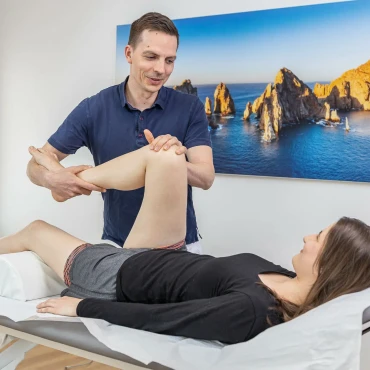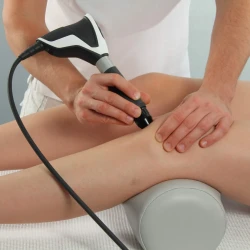Knee pain
The knee joint is the most complex, largest and most sensitive joint in the human body. Knee pain is stressful for those affected and not only restricts their quality of life, but often also their ability to work and play sport.
The causes of knee joint pain can be numerous. The most common are so-called functional knee pain, which can be attributed to muscular complaints, irritation of the capsule-ligament apparatus or tendon irritation such as pesanserinus syndrome or patellar tendinopathy. People who are particularly active in sports have an increased risk of knee injuries. Among the most common are meniscus tears and cruciate ligament tears - often caused by
an accident. However, chronic overloading, which results in joint wear and tear (osteoarthritis), can also be the cause of pain. In addition, there are a number of other diseases that lead to discomfort in the knee joint. An early and accurate diagnosis by an experienced orthopaedic surgeon is always necessary in order to be able to initiate the best individual treatment with the aim of relieving or alleviating pain.
A distinction must be made between acute and chronic pain in the knee. Acute pain occurs suddenly and is usually triggered by an accident or trauma.
Knee pain treatment
The treatment of knee pain depends on the cause diagnosed by the orthopaedist during the examination.
In our holistically orientated private practice for orthopaedics and osteopathy in Freiburg, we start by treating knee pain with manual therapy and osteopathy of the overall statics, starting with the pelvic-leg chain, as a tarsal blockage or a blockage in the area of the sacroiliac joints can also be responsible for the pain. We also place particular emphasis on treating the muscles and their trigger points. In addition to manual techniques, trigger point acupuncture and shock wave therapy (ESWT) is a non-invasive procedure that can be used to treat many causes of knee pain. We use them in trigger point treatment and in the treatment of irritated tendon insertions, among other things.
In addition to orthopaedic treatment of knee pain, special home training is also recommended to strengthen the affected structures.
Regenerative injections and/or hyaluronic acid are often successful, particularly in the case of inflammatory processes in the knee and osteoarthritis in the knee joint, and are an integral part of our treatment concept.
If static dysfunctions, foot misalignments or an anatomical difference in leg length are responsible for the complaints, the first step can be to provide foot orthoses. Customised special insoles are ideal for treating static complaints of the postural and musculoskeletal system.


Book a consultation appointment now!
A quick, simple and easy way to your appointment.
Functional knee pain
While acute, structural pain is often the result of acute trauma, functional knee pain is often caused by unphysiological stress or overloading of the joint. It is not uncommon for knee pain to be caused by imbalances in the capsule-ligament apparatus or in the muscles. For example, functional disorders such as pelvic misalignment, foot misalignment or muscular imbalances are often responsible. They lead to a change in the body's statics, which can not only cause pain in the spine but also in the knee. Muscular tension and so-called trigger points, which have arisen as a result of prolonged incorrect/overloading, can also cause pain. The aim here is to uncover the structures and imbalances responsible in order to achieve long-term therapeutic success and freedom from pain in the knee joints.
Tendon irritation: often the cause of functional knee pain
Tendinopathies are also a common cause of functional knee pain. We use this term to describe tendon irritation, usually caused by overloading, e.g. of the patellar tendon (patellar tendon) or the adductor muscles (pes anserinus).
The patellar tendon is the connection between the thigh muscle and the kneecap (patella). Patellar tendinopathy is also known as "jumpers knee", as the condition often occurs in athletes who play sports that involve a lot of jumping. However, it can also affect people who do not play any sport or other sports. Patellar tendonitis is caused by unaccustomed strain on the knee or the patellar tendon.
Pes anserinus refers to a tendon that is formed by the tendons of three muscles on the inside of the thigh and is located in a common tendon in the centre front area of the tibial plateau slightly below the knee joint space. Pes anserinus syndrome occurs when there is inflammation in this tendon and its bony insertion. This condition, which is easily confused with a meniscus problem, is often caused by imbalances, overloading, strains or chronic tension in this muscle group. Typical symptoms are pain on the inside of the knee joint, often accompanied by tenderness to the touch. Painful tension or active trigger points in the adductor muscles, which cause pain to radiate into the pes anserinus, are also a common cause of pain. There may be a connection here with pelvic obliquity, which can be caused by a blockage of the sacroiliac joint (SIJ). A thorough examination and diagnosis by an orthopaedist will determine the individual cause of the pain and treat it accordingly (see below).
Knee pain due to joint wear and tear
Chronic overloading of the knee joint eventually leads to joint wear and tear, or osteoarthritis. This is a degenerative disease caused by a continuous state of irritation in the joint and the associated wear and tear of the joint cartilage. The cartilage gradually softens and wears away until, in the final stage, all the cartilage is used up and bone rubs against bone, causing severe pain in the knee. Even though osteoarthritis often develops at an advanced age, i.e. it is an age-related disease, risk factors such as joint injuries, lack of exercise or obesity also play a role in its development. Osteoarthritic cartilage can no longer be "cured", but as the pain is essentially due to the irritation of the joint, osteoarthritis pain can often be treated well and the progression of the disease can at least be slowed down.
Knee pain in children
It is not uncommon for children - especially those who are active in sports - to suffer from knee pain, which is often caused by irritation or disease of the patellar tendon. Depending on the localisation, this is known as Sinding-Larsen's disease or patellar tendinopathy or Osgood-Schlatter's disease (lower area of the patellar tendon). Both conditions are benign and have a good prognosis if diagnosed and treated in good time. Treatment is always conservative, i.e. without surgery.
Acute knee pain due to knee injuries - examples
-
Meniscus tear
This usually occurs due to a degenerative change as a result of a knee injury in which the patient has twisted their knee. The meniscus then usually tears in the part where it is neither supplied with blood nor nerves. Although this means that the meniscus injury usually does not heal, it also means that the meniscus injury itself is not painful. The pain in a meniscus lesion is caused by the torn part of the meniscus becoming trapped in the knee joint space during movement, causing traction on the meniscus attachment, which is very sensitive to pain. For this reason, meniscus injuries can often be treated without surgery. The aim of conservative therapy is to reduce the irritation of the knee joint and to bridge the time until the defect in the meniscus has healed somewhat.
-
Ligament injuries
Ligament injuries are caused by extreme forces acting on the knee joint, e.g. during a fall. The inner ligament and the anterior cruciate ligament are frequently affected. While strains or partial tears are always treated conservatively, a complete tear of the anterior cruciate ligament sometimes requires surgery. This must be weighed up on an individual basis. However, recent findings from international professional sport are increasingly in favour of an initial attempt at conservative treatment. In addition to intensive physiotherapeutic rehabilitation measures, regenerative injections with platelet-enriched plasma (so-called platelet-rich plasma) can improve or accelerate healing.
-
Dislocation of the kneecap / patella luxation
The kneecap can slip outwards (luxate) in patients with a tendency to "hypermobility" as part of a knee joint injury, resulting in tears to the capsule-ligament apparatus or even cartilage damage. This can result in permanent instability of the knee joint, which is why they need to be treated quickly and consistently.
-
Fractures of the kneecap or the upper or lower leg bones caused by an accident often require surgery.
Taking knee pain and complaints seriously
Many diseases of the knee joint can be successfully treated conservatively, i.e. without surgery. However, in order to counteract premature wear and tear or chronic progression in good time, knee pain should always be treated immediately by an orthopaedic surgeon. With the help of a detailed and holistic diagnosis, the causes can be determined and targeted treatment can be initiated.
If you have a painful knee, we will be happy to help you at our OrthoPassion practice. Our aim is to help you effectively and quickly with customised treatment modules and an individual therapy plan to restore your quality of life and mobility.

